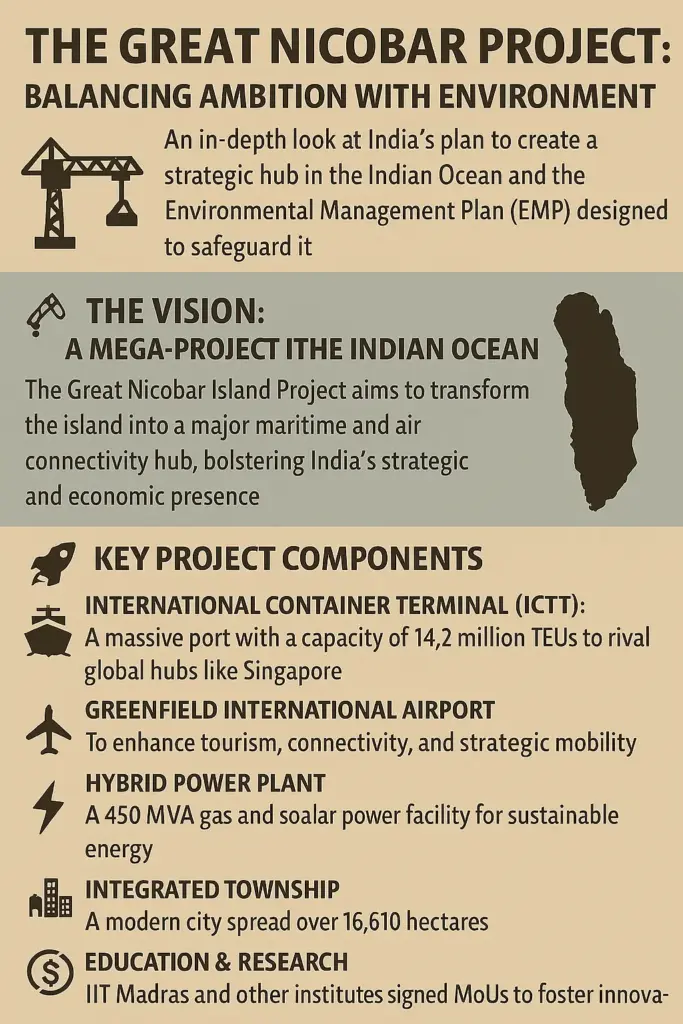September 12, 2025
Great Nicobar Project: The Controversial Blueprint and 5 Critical Challenges
ENVIRONMENTAL MANAGEMENT PLAN (EMP)
The Great Nicobar Island Project, an ambitious integrated development initiative by the Government of India, has been approved to transform Great Nicobar Island into a major maritime and air connectivity hub in the Indian Ocean Region (IOR). The project has strategic and national security significance but has also raised concerns about environmental impact, tribal welfare, and ecological balance.
KEY POINTS: ENVIRONMENTAL MANAGEMENT PLAN (EMP)
- Project Components
- International Container Transshipment Terminal (ICTT):
- Capacity of 14.2 million TEUs (Twenty-Foot Equivalent Units).
- Aimed at making India a global shipping hub, reducing dependence on foreign ports like Colombo and Singapore.
- Greenfield International Airport:
- Designed to boost tourism, connectivity, and strategic movement.
- Power Infrastructure:
- 450 MVA power plant combining gas and solar energy to ensure sustainable electricity supply.
- Integrated Township:
- Spread over 16,610 hectares to house workers, port staff, and support industries.
- Area and Phased Development:
- Total Area: 166.10 sq. km
- Revenue land: 35.35 sq. km
- Forest land: 130.75 sq. km
- Phases:
- Phase I (2025-2035): 72.12 sq. km
- Phase II (2036-2041): 45.27 sq. km
- Phase III (2042-2047): 48.71 sq. km
- Environmental Safeguards & Measures:
- Environmental Impact Assessment (EIA) conducted under EIA Notification, 2006.
- Environmental Management Plan (EMP):
- Detailed mitigation strategies to minimize harm to wildlife and forests.
- ₹81.55 crore was released even before construction for conservation and research activities.
- Risk Assessment Study:
- Based on natural disasters (cyclones, tsunamis) and anthropogenic threats.
- Disaster management and vulnerability plans prepared.
SIGNIFICANCE:
Strategic & Defence Importance:
- Strengthens India’s presence in the Indian Ocean Region amidst rising Chinese influence.
- Key node for maritime trade security and naval operations.
- Reduces India’s dependence on foreign ports for transshipment.
Economic Growth:
- Boost to shipping, logistics, and tourism sectors.
- Expected to generate large-scale employment opportunities.
- Supports India’s vision of becoming a global maritime hub under the Sagarmala Programme.
Infrastructure Development:
- Enhances connectivity between mainland India and Andaman & Nicobar Islands.
- Promotes development of underutilized islands with modern facilities.
CHALLENGES / ISSUES:
- Environmental Concerns:
- Clearing of forest land (130.75 sq. km) may affect biodiversity and ecosystems.
- Threat to marine life and coastal ecosystems despite mitigation plans.
- Possible disturbance to nesting grounds of rare species like Leatherback Turtles.
- Tribal Welfare Issues:
- The island is home to indigenous tribes such as Shompens and Nicobarese.
- Risk of cultural displacement and loss of traditional livelihood patterns.
- Disaster Vulnerability:
- Great Nicobar is in a high seismic zone, making it prone to earthquakes and tsunamis.
- Need for robust disaster resilience infrastructure.
- Strategic Geopolitical Concerns:
- Rising China-India competition in the Indian Ocean region.
- Possible militarization of the island leading to regional tensions.
- Implementation Hurdles:
- High costs and long timelines spread across three phases.
- Coordination challenges between central and local authorities.
STEPS NEEDED / WAY FORWARD:
- Environmental Protection:
- Strict enforcement of EIA guidelines and continuous ecological monitoring.
- Establish marine biodiversity sanctuaries and eco-sensitive zones.
- Promote green infrastructure using renewable energy sources.
- Tribal Safeguards:
- Ensure free, prior, and informed consent of local tribes before implementation.
- Provide rehabilitation packages, healthcare, education, and livelihood opportunities.
- Preserve tribal cultural heritage through legal safeguards.
- Disaster Resilience:
- Construct earthquake-resistant buildings and early warning systems.
- Prepare tsunami shelters and evacuation plans.
- Strategic Partnerships:
- Develop the island as a dual-use facility — both commercial and defence.
- Strengthen cooperation with QUAD and IOR nations to secure sea lanes.
- Balanced Development:
- Regular review of environmental and social impacts.
- Encourage community participation in planning and monitoring.
- Phase-wise rollout to avoid sudden ecological stress.
About ENVIRONMENTAL MANAGEMENT PLAN (EMP):
The Environmental Management Plan (EMP) is a comprehensive framework of strategies, actions, and measures prepared to prevent, mitigate, and manage environmental impacts arising from a developmental project during construction, operation, and decommissioning phases.
It ensures that development projects are sustainable, comply with legal and regulatory standards, and protect natural resources, biodiversity, and community interests.
It is a mandatory component of the Environmental Impact Assessment (EIA) process under the EIA Notification, 2006 (as amended).
OBJECTIVES OF EMP
- To identify potential environmental impacts during all stages of a project.
- To minimize negative effects on air, water, land, flora, fauna, and human health.
- To provide a roadmap for mitigation measures and sustainable resource use.
- To ensure legal compliance with environmental standards and policies.
- To facilitate monitoring and management of environmental performance.
To promote sustainable development by integrating environmental safeguards into project planning.
October 6, 2025
September 24, 2025
September 23, 2025
September 22, 2025

